EDITOR’S NOTE: This article was verified by Temitope Adeleke, a writer and food enthusiast based in Lagos, Nigeria.
Nigerian food, like many cuisines in West Africa, is known for being spicy and aromatic. Jollof rice is perhaps the most famous Nigerian dish but the cuisine has so much more to offer, especially with its abundance of richly flavored soups and stews and equally plentiful “swallow” foods.
Unfortunately, Nigerian food isn’t as well-known globally as other cuisines but thanks to the Nigerian diaspora, that may be changing. Nigerian recipe bloggers, many of whom have moved to different parts of the world, continue to champion Nigerian cuisine and help bring it into the global consciousness. Go through their comments sections and you’ll find no shortage of foreigners happy to try Nigerian dishes that were previously unknown to them!
Thanks to the internet, Nigerian cuisine is becoming more internationally well-known. More and more people are becoming curious about Nigerian food. If you’re one of those people, then this list of 25 must-try Nigerian dishes will whet your appetite even more.
Save This on Pinterest!
No time to read this Nigerian food guide now? Click on the save button and pin it for later!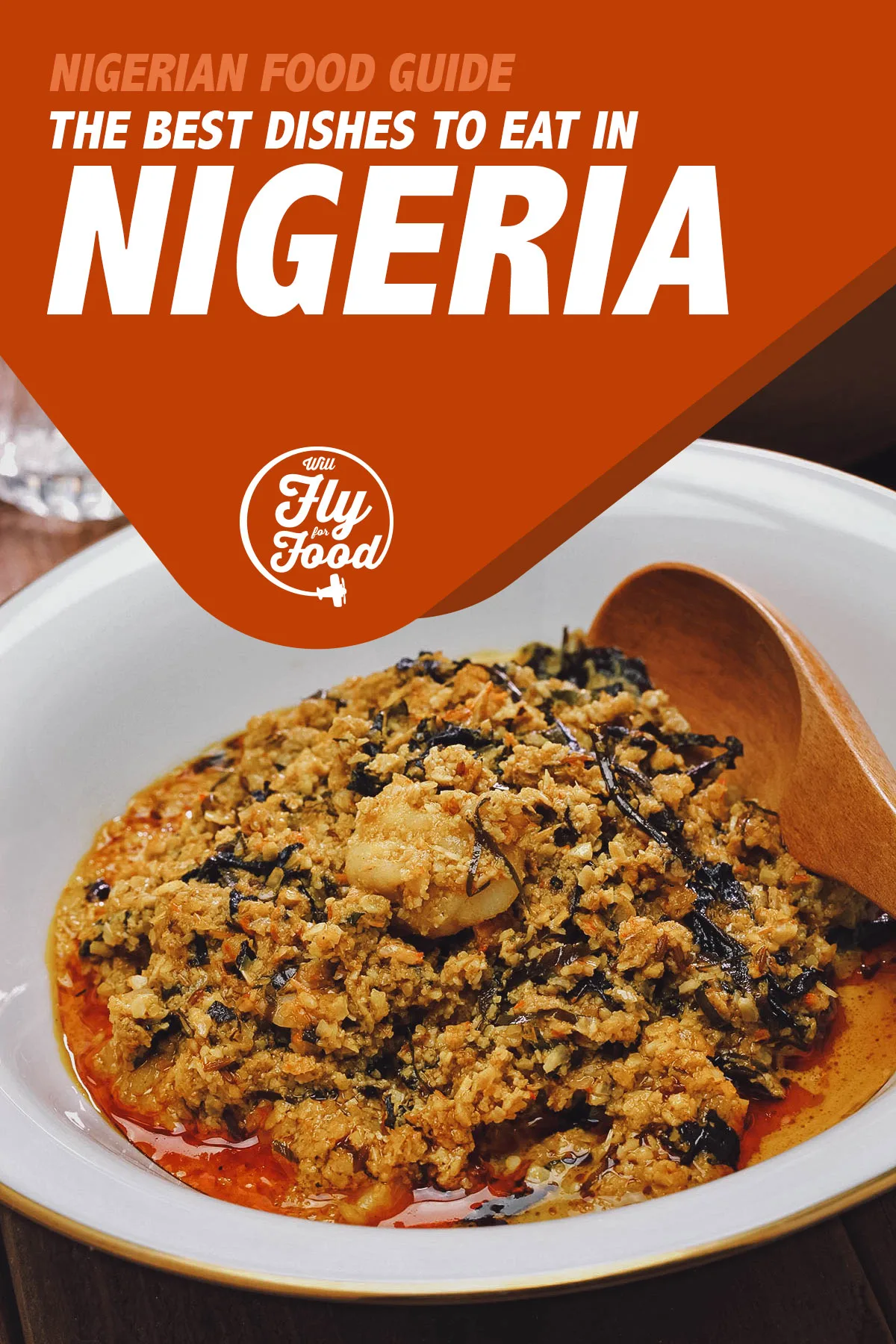
Photo by asimojet
WHAT IS NIGERIAN FOOD?
Nigerian food represents the cuisines of the more than 250 ethnic groups that comprise Nigeria. It shares many similarities with the cuisines of its West African and Central African neighbors like Ghana, Benin, and Cameroon.
Starchy foods like yam, cassava, plantains, rice, and beans figure prominently in the Nigerian diet. They’re often consumed with a wide array of hearty soups and stews made with different types of meat and vegetables. Nigerians are fond of vegetable stews and typically consume it several times a week.
Nigerian cuisine practices snout-to-tail dining so very little of the animal goes to waste. Popular meats include beef, goat, lamb, chicken, and turkey while some of the most widely consumed vegetables are Lagos spinach, African spinach, water leaves, pumpkin leaves, and jute leaves.
Go through the ingredient list of many Nigerian recipes and you’ll find that ground African crayfish, dry ground pepper, and Maggi cubes are common seasonings. Palm and groundnut oil are also widely used.
MUST-TRY NIGERIAN DISHES
A list of 25 dishes can be a lot to get through so this Nigerian food guide has been organized by category to make it easier to digest. Click on a link to jump to any section of the guide.
STAPLE FOOD
1. Fufu
Fufu (or foofoo, foufou) is one of the most commonly eaten Nigerian foods. It refers to a staple food made from cassava (fermented or unfermented) that’s been boiled, pounded, and then formed into balls.
Traditionally, fufu refers to a staple Nigerian food made with cassava. However, the definition has expanded over the years to include other staple foods made from similarly starchy ingredients like yam, plantains, maize, wheat, rice, and semo. The term fufu refers to a specific dish but it can also be used as an umbrella term to describe a family of starchy staple foods commonly eaten in Nigeria, Ghana, and other parts of Africa.
To make fufu, boiled cassava is peeled and then cut into small cubes before pounding. Traditionally, a large wooden mortar and pestle is used. The cassava is pounded into a smooth and sticky mixture before being shaped into balls and served. It’s popular throughout western and central Africa and is typically eaten with different types of soups and stews.
Fufu – like pounded yam, amala, and eba – is a type of Nigerian swallow food. Swallow foods are starchy doughy dishes that are soft and pliable enough to swallow without chewing. To eat, a small portion is torn off and used as a scoop for soups and stews. Like many staple foods, it has a mild taste, similar to potatoes.
RECIPE: Fufu
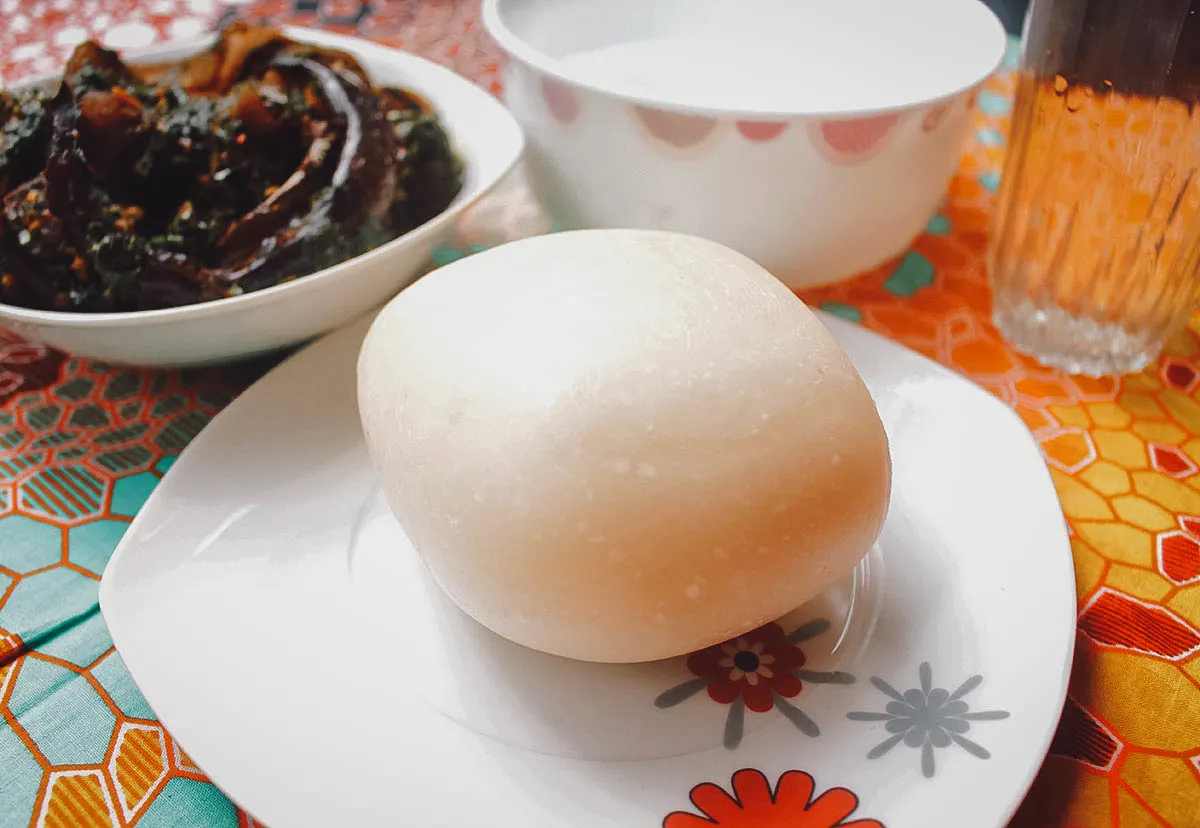
Photo by Afrofresh
2. Eba
Eba is a popular Nigerian swallow food made with dried and fried cassava flour called garri. It’s eaten like fufu and often served alongside many Nigerian soups and stews.
To prepare, cassava tubers are peeled and crushed into a mash before being pressed, dried, and fried to produce a dry granular flour called garri. The garri is then mixed with boiling water to form a smooth stiff dough that’s shaped into balls and consumed.
Eba can be either off-white or yellowish in color. Yellow eba is made with garri that’s been fried in palm oil.
RECIPE: Eba
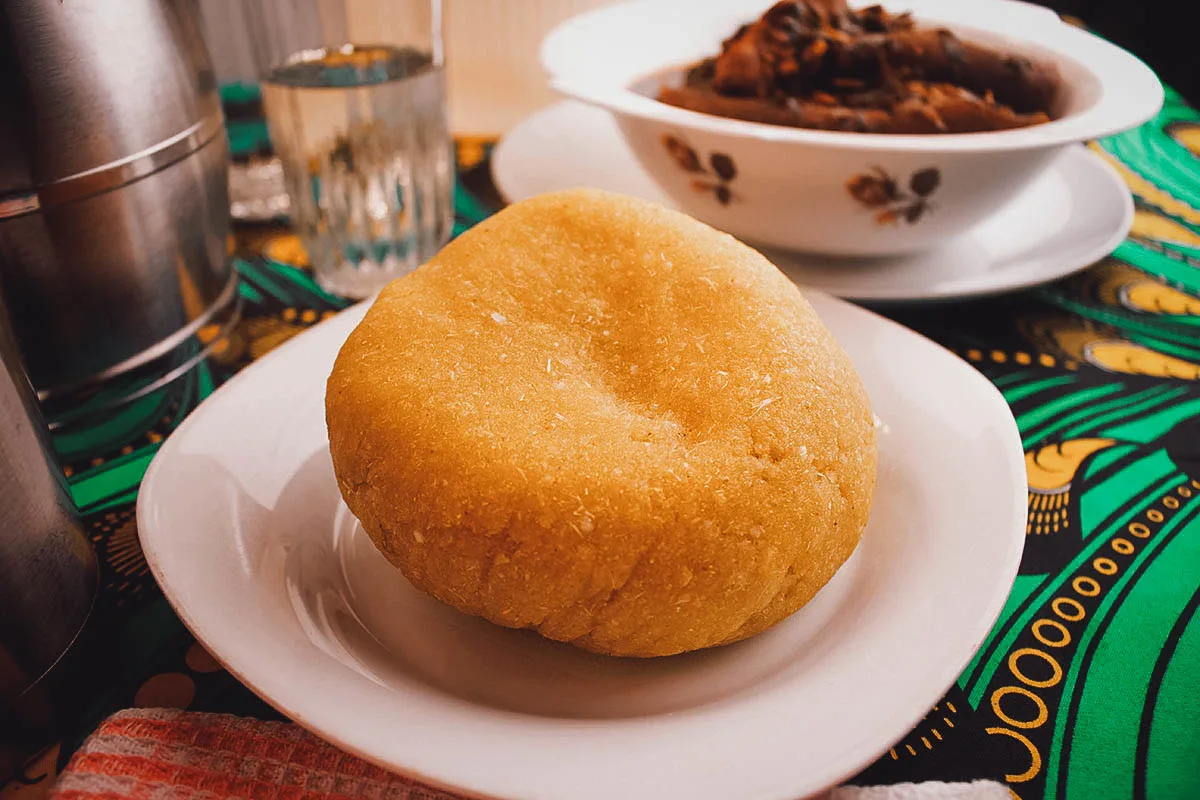
Photo by Afrofresh
3. Tuwo Shinkafa
Tuwo Shinkafa is a type of Nigerian swallow food associated with the Hausa people of northern Nigeria. It’s traditionally made with short-grain rice but it can be made with rice flour as well.
To prepare, the rice is boiled until it absorbs the water and becomes soft and sticky. It’s then mashed into a soft dough, shaped into the container that it’s introduced to, and formed into balls before being served as an accompaniment to Nigerian soups like miyan kuka and miyan kardashi.
RECIPE: Tuwo shinkafa
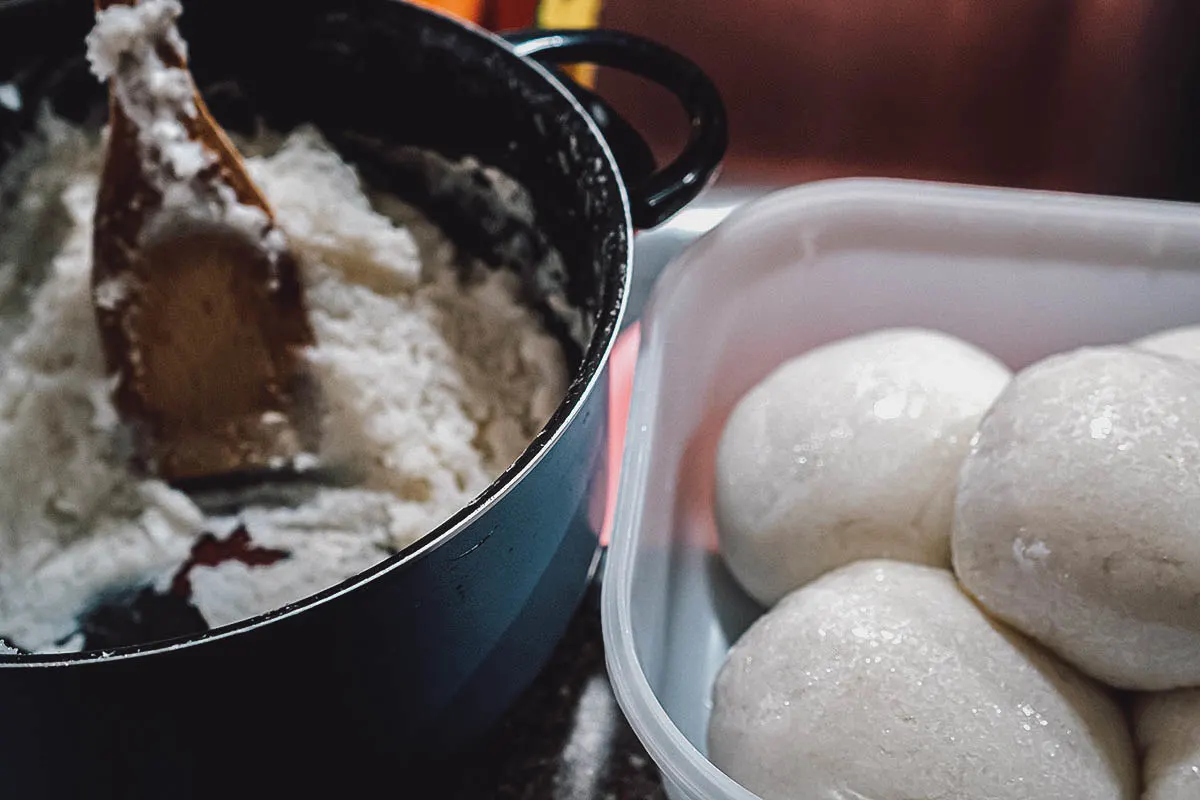
Photo by primestockphotography
4. Jollof Rice
Jollof rice is a one-pot rice dish that’s popular in many West African countries like Nigeria, Ghana, Sierra Leone, Senegal, Togo, and Gambia. It’s made with rice, tomatoes, tomato paste, onions, pimento peppers, scotch bonnet peppers, salt, and other spices.
Jollof rice is one of the most widely consumed dishes in West Africa. It’s regarded as a national dish in Nigeria and often served with some type of meat like chicken, turkey, beef, or fish. Many variations of jollof rice exist in West Africa with two of the most well-known being the Nigerian and Ghanian versions.
Nigerians and Ghanians are so passionate about this dish that it’s sparked the “Jollof wars” – a heated but friendly debate on which nation makes the best version of this beloved dish. The two versions are fairly similar with the one main difference being that Nigerian jollof rice is made with long-grain rice while the Ghanian version is made with more aromatic basmati.
RECIPE: Nigerian jollof rice
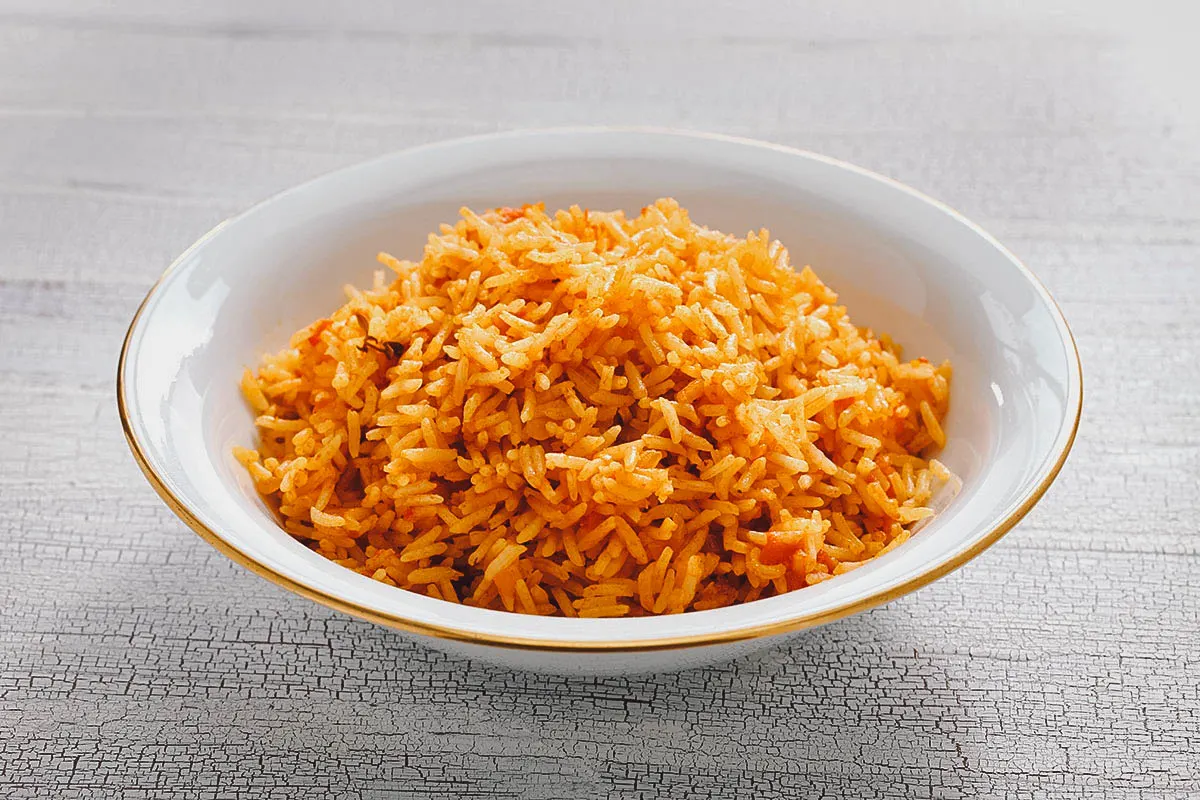
Photo by asimojet
SOUPS / STEWS
5. Egusi Soup
Egusi soup with fufu is considered by many to be a Nigerian national dish. Egusi refers to the protein-rich seeds of plants like squash, melon, and gourd that when dried and ground become a staple ingredient in many West African and Nigerian foods. One of those dishes is egusi soup.
Egusi soup is a one-pot meal typically made with ground egusi, palm oil, onions, hot peppers, locust beans (iru), African crayfish, stockfish, some type of meat, fish, and leafy vegetables. Other than fufu, it can served with other Nigerian swallow foods like eba, amala, or pounded yam.
RECIPE: Egusi soup
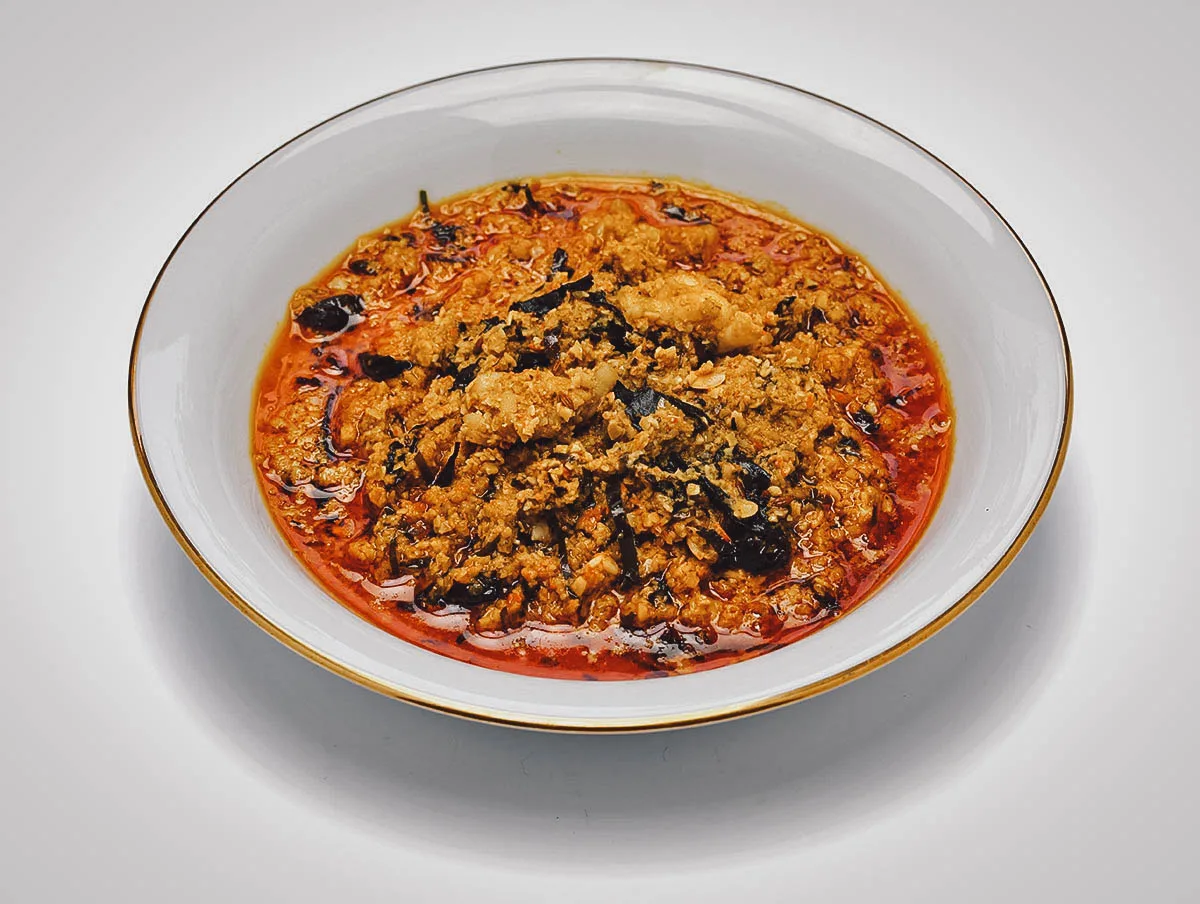
Photo by asimojet
6. Amala and Ewedu Soup
Ewedu soup is a Nigerian soup made with jute leaves, a type of leafy vegetable common in tropical and subtropical parts of the world. It’s native to the Yoruba people of western Nigeria but it’s common in other parts of West Africa, East Africa, and North Africa as well.
To prepare, jute leaves are mashed, often with a short broomstick called ijabe, and then cooked with ground African crayfish, bouillon powder, salt, and locust beans. When cooked, the leaves develop a somewhat slimy viscosity similar to okra.
Ewedu soup is commonly paired with amala but it can be eaten with other types of Nigerian swallow food like fufu, eba, or pounded yam. Amala is typically made with dried yam (amala isu) which gives it a brown color, but it can be made with cassava (amala lafun) or plantain (amala ogede) as well.
Ewedu soup can be served on its own with amala, but it isn’t uncommon to find it served with other types of Nigerian stew as well like buka stew and/or gbegiri soup. As you can probably guess, the bowl of green soup below is ewedu soup.
RECIPE: Amala and ewedu soup
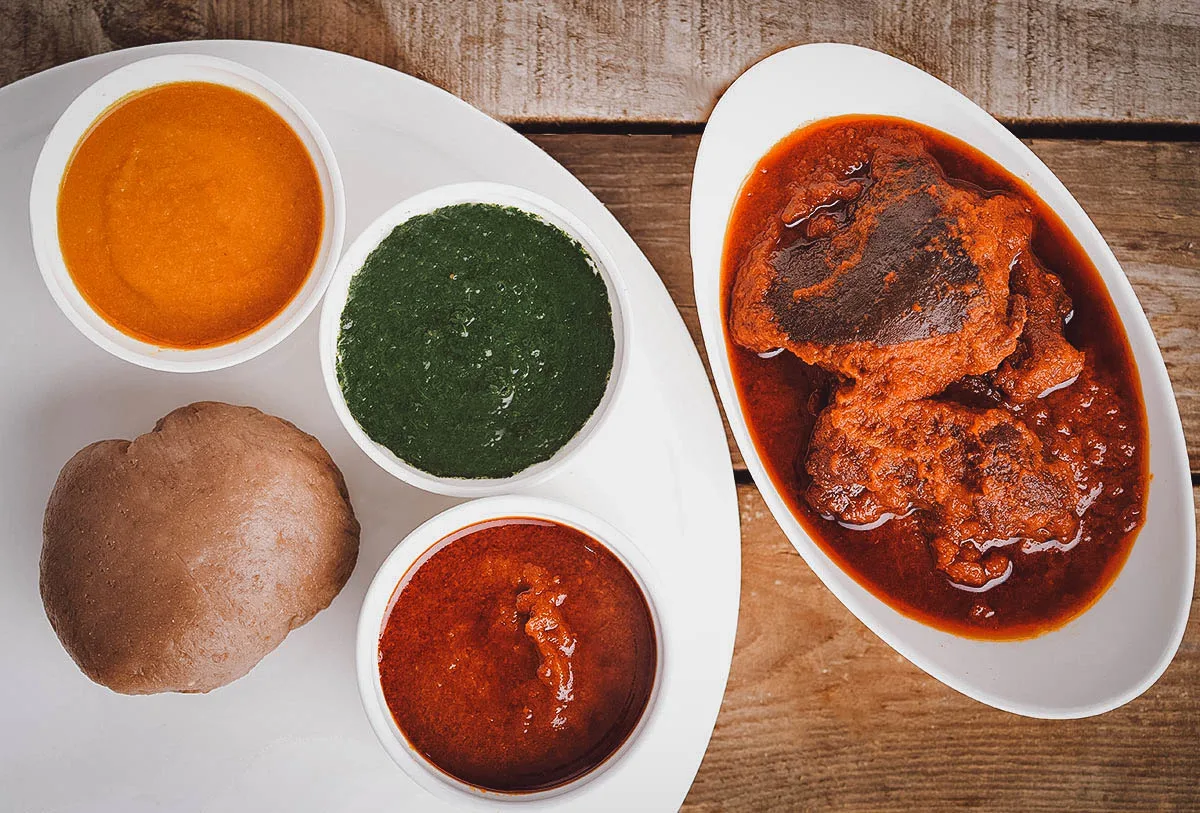
Photo by Afrofresh
7. Pepper Soup
Pepper soup is one of the most popular types of soup in Africa. It’s a spicy and watery soup made with peppers and an assortment of meat like goat, chicken, oxtail, or fish. It’s a comforting Nigerian dish that’s often enjoyed with beer and consumed in many variations in Ghana, Liberia, and in most other parts of western Africa.
Pepper soup made with chicken is said to have medicinal qualities while versions made with yam are especially popular with new mothers. It’s believed that consuming yam pepper soup shortly after giving birth has a cleansing effect on the uterus and aids in milk production.
RECIPE: Pepper soup with goat meat
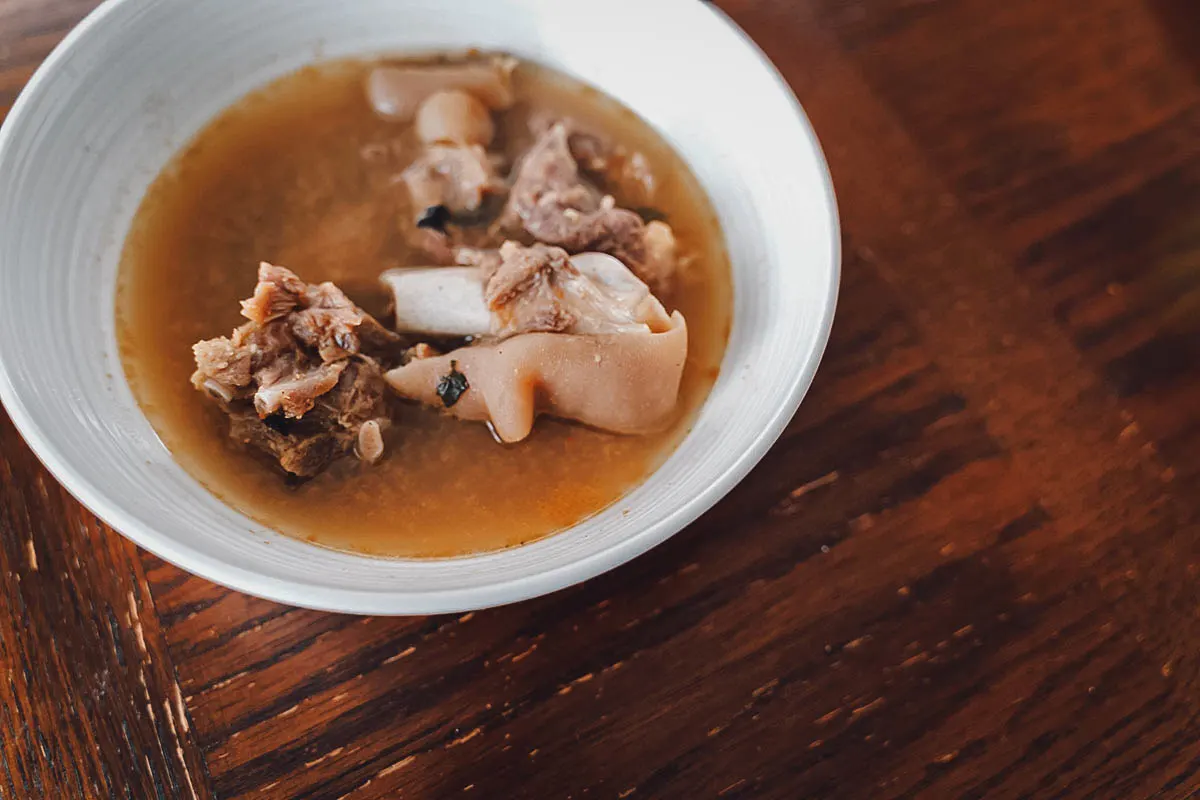
Photo by primestockphotography
8. Ogbono Soup
Ogbono soup is a type of Nigerian stew made with different types of vegetables, meat, and fish cooked in a broth thickened with ground dry ogbono seeds (wild mango seeds).
Ogbono refers to a species of African tree that bears edible mango-like fruit. They’re especially prized for their fat- and protein-rich seeds that are often ground and used as a thickening or flavoring agent in Nigerian soups. They have a distinct aroma and develop a slimy viscosity when cooked, similar to okra or jute leaves in ewedu soup.
Like many Nigerian soups and stews, ogbono soup is typically eaten with swallow foods like fufu or pounded yam.
RECIPE: Ogbono soup
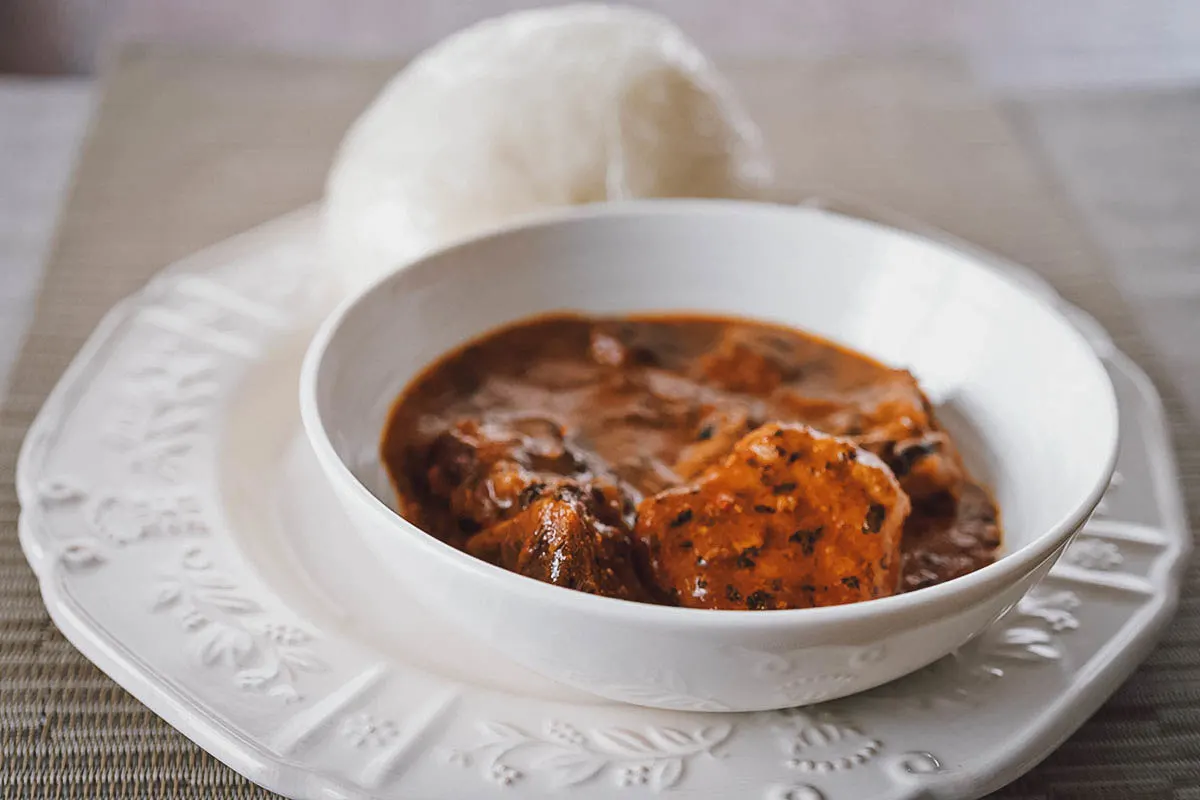
Photo by primestockphotography
9. Banga Soup
Banga soup refers to a hearty Niger-Delta style soup made with palm nut. It’s native to the Urhobo people in Nigeria’s Delta State but it’s become a continental soup that’s widely consumed throughout Africa.
Depending on where it’s from, banga soup can be prepared in different ways but it’s usually made with fresh palm fruit and a variety of meat, fish (mostly catfish), and seafood flavored with spices like beletete leaves (bush apple), oburunbebe stick (licorice), banga spice leaves, scotch bonnet peppers, and onions.
Like most of the soups in this Nigerian food guide, banga soup is often served with swallow foods like pounded yam or eba.
RECIPE: Banga soup
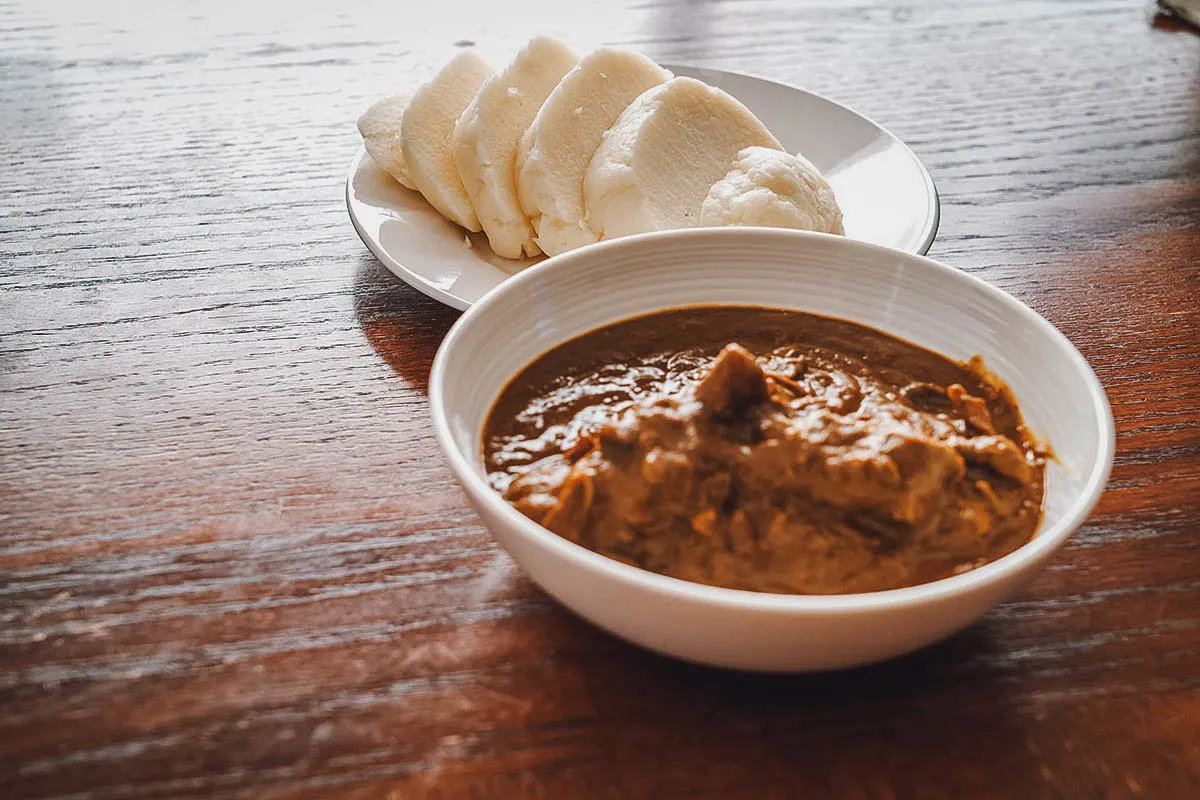
Photo by primestockphotography
10. Edikang Ikong Soup
Edikang ikong soup refers to a type of Nigerian vegetable soup dish native to the Efik people of southern Nigeria. It’s made with a generous amount of ugu (fluted pumpkin) and water leaves (Malabar spinach) cooked with palm oil and different types of meat and seafood like beef, tripe, cow feet, ponmo, dried fish, African crayfish, and periwinkle (sea snail).
While considered a highly nutritious dish, edikang ikong is expensive to make. It’s been described as a Nigerian dish eaten mostly by the rich. For some people, it’s a delicacy reserved for special occasions where it’s commonly paired with Nigerian swallow foods like fufu, eba, or pounded yam.
RECIPE: Edikang ikong soup
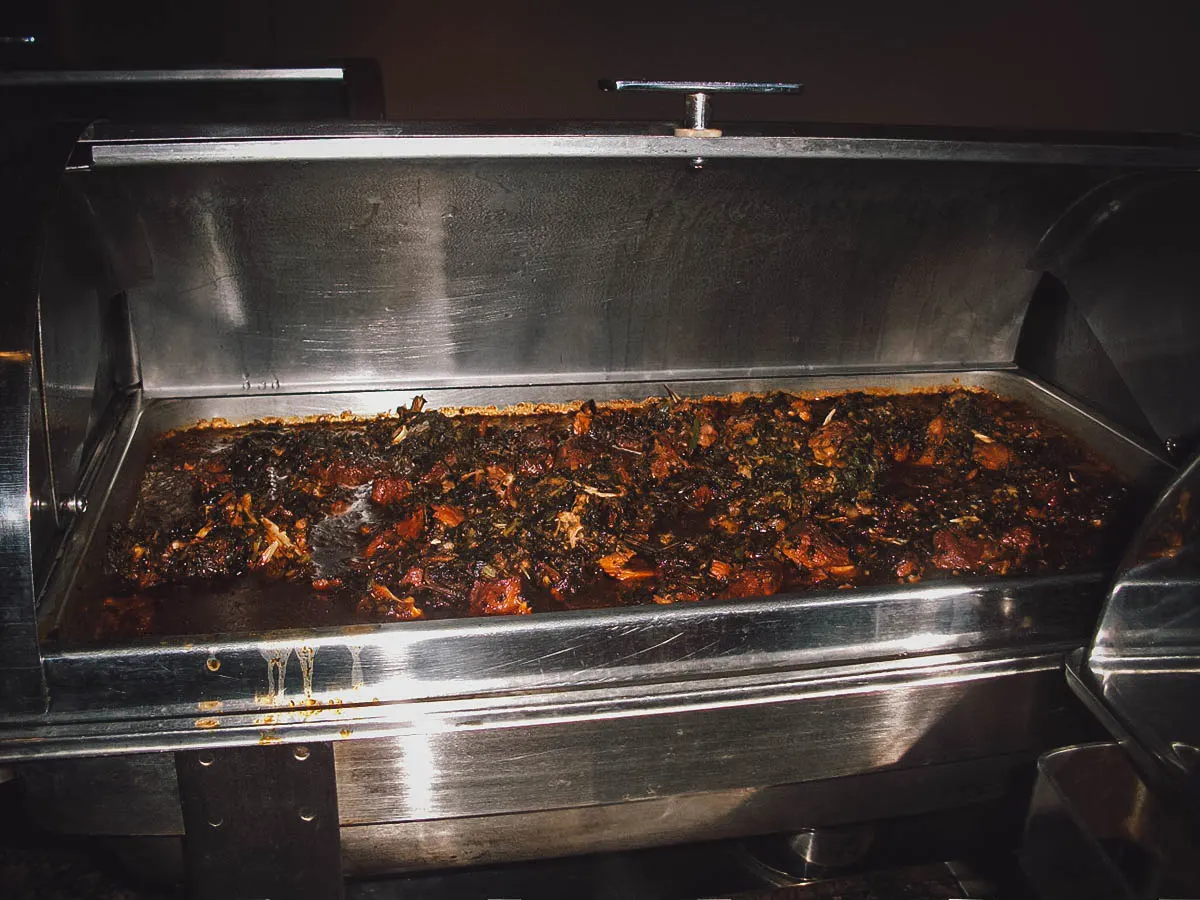
Nne75, CC BY-SA 4.0, via Wikimedia Commons / Processed in Photoshop and Lightroom
11. Afang Soup
Like edikang ikong, afang soup is a type of Nigerian vegetable soup dish native to the Efik people of southern Nigeria. It’s very similar to edikang ikong soup except it’s mainly a vegetable dish made with water leaves and okazi leaves (African jointfir) as its primary ingredient.
Afang soup is known throughout Nigeria though it’s especially popular with the Ibibio and Anang people of Akwa Ibom and Cross River State in southern Nigeria. It’s commonly prepared at home and served at ceremonies like weddings, traditional marriages, and funerals with swallow foods.
RECIPE: Afang soup
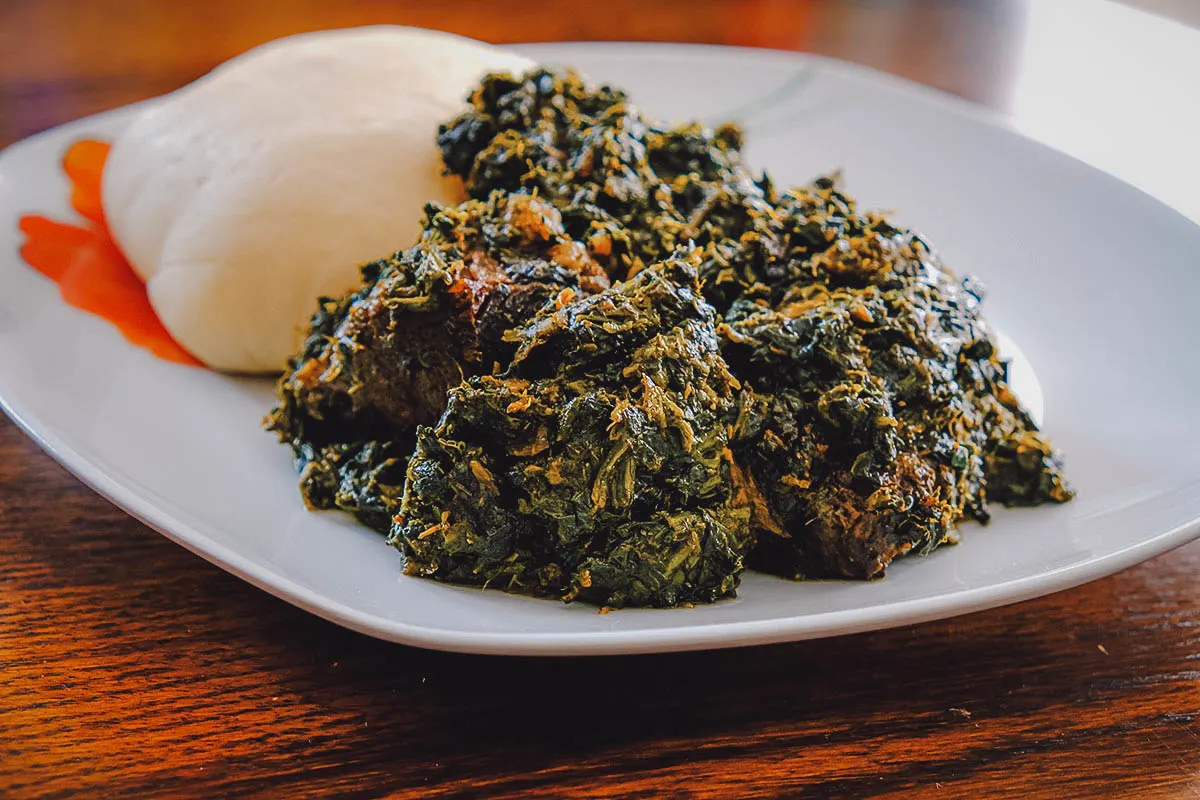
Photo by primestockphotography
12. Ofada Stew
Ofada stew refers to a rich stew made with bleached palm oil, red bell peppers, locust beans, African crayfish, and different types of meat like beef, tripe, cow foot, and ponmo. It’s native to the Yoruba people though it’s commonly enjoyed throughout Nigeria.
Ofada stew is often referred to as ayamase stew. They’re almost identical dishes with the only difference being that the latter is made with green instead of red bell peppers. Ofada stew is typically served with plain white rice or Ofada rice, which is a type of unpolished short-grain rice grown in southwest Nigeria.
RECIPE: Ofada stew
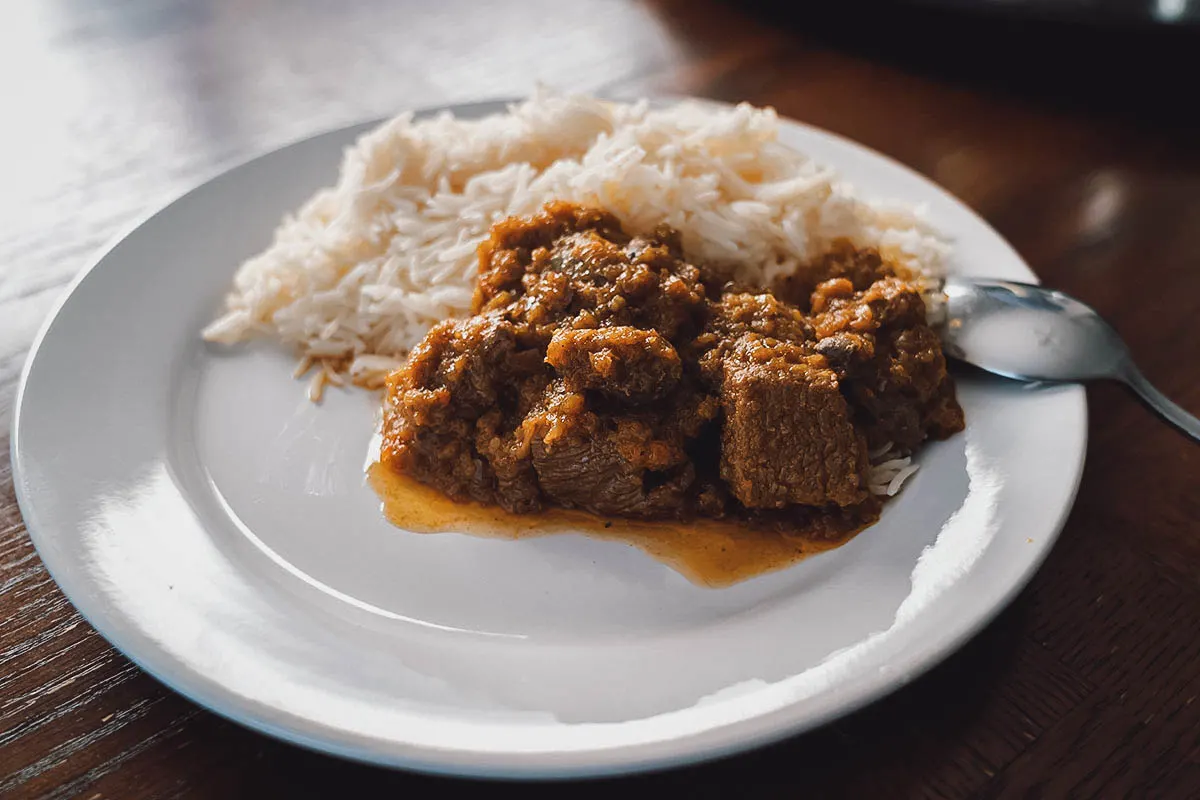
Photo by primestockphotography
13. Efo Riro
Efo riro is another Nigerian dish native to the Yuroba people. It refers to a one-pot spinach stew made with red bell peppers, locust beans, onion, palm oil, African crayfish, and stockfish. It’s typically made with Lagos spinach (efo shoko) or African spinach (efo tete) and can contain different types of meat or fish.
In the Yoruba language, efo refers to “spinach” while riro means “to stir”, so efo riro roughly translates to “stirred spinach”. It can be paired with rice or a swallow food like eba, fufu, or pounded yam.
RECIPE: Efo riro
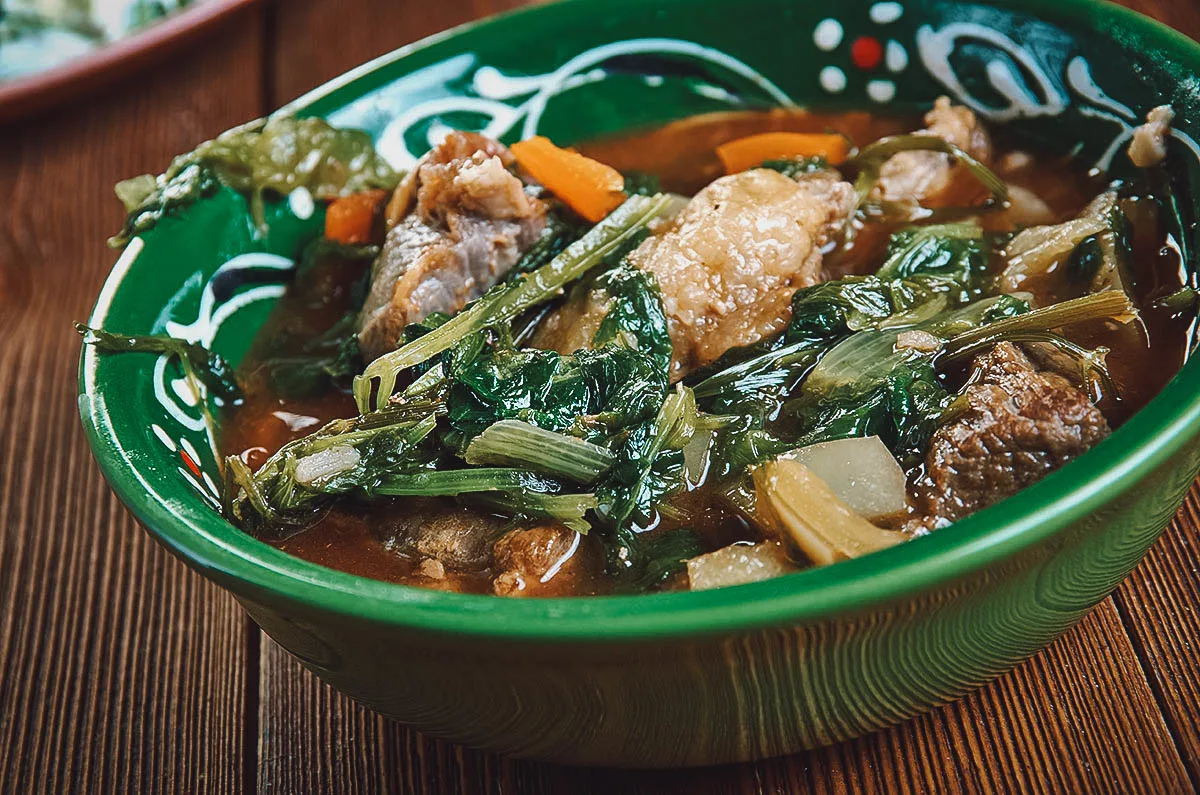
Photo by fanfon
SALAD / SIDE DISHES
14. African Salad (Abacha and Ugba)
Abacha and ugba refers to a cassava-based dish native to the Igbo people of eastern Nigeria. Also known as African salad, it’s a two-part dish made with dried shredded cassava (abacha) and fermented African oil bean seeds (ugba).
To prepare, cassava tubers are cooked and then shredded with a special grater. The cassava shreds are then soaked overnight before being washed and left to dry under the sun. When the abacha is ready, it’s mixed together with sliced ugba and a host of other ingredients like palm oil, dried fish, ground African crayfish, locust beans, ground ehu seeds (calabash nutmeg), ponmo, and a hard-boiled egg.
Even though abacha and ugba can be a filling Nigerian dish, it’s typically enjoyed as a snack rather than a full meal.
RECIPE: Abacha and ugba
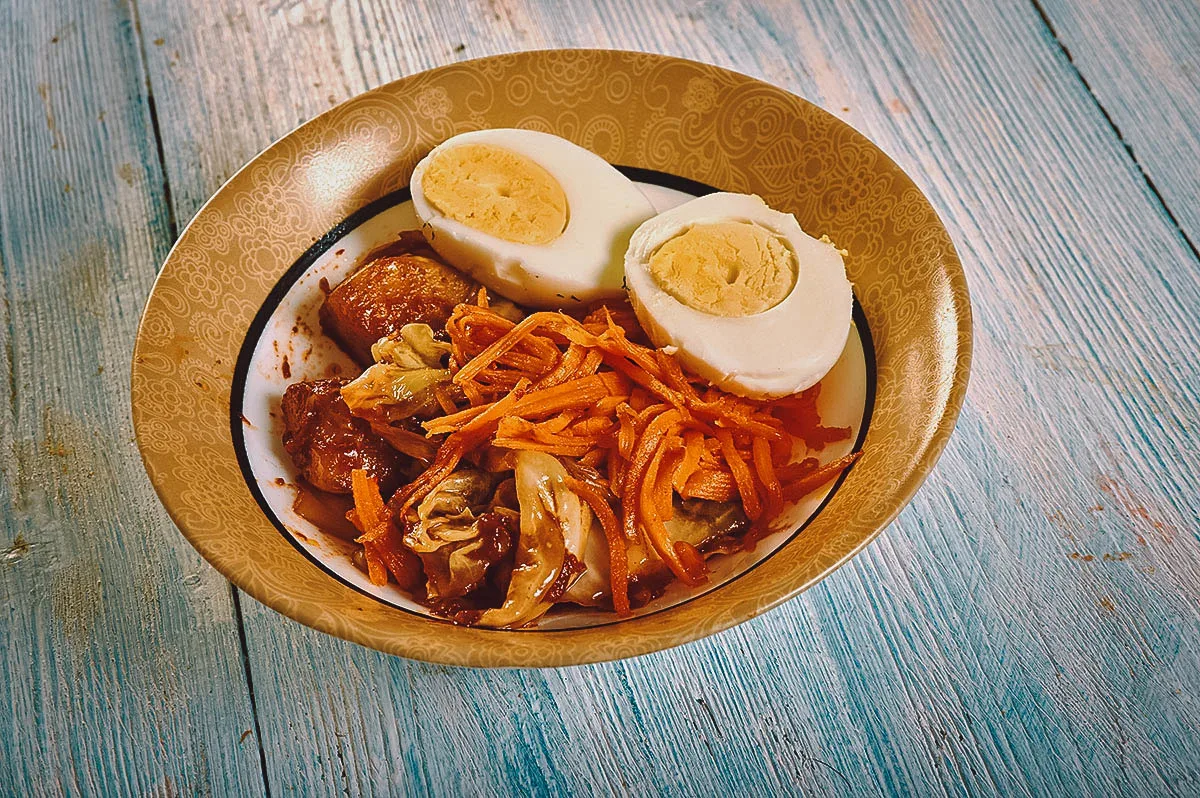
Photo by fanfon
15. Dodo
Dodo refers to deep-fried and caramelized ripe plantains. They can be eaten on their own with eggs and tomato sauce or served as a side dish to Nigerian foods like jolllof rice, white rice, beans, and ewa riro (stewed beans).
RECIPE: Dodo
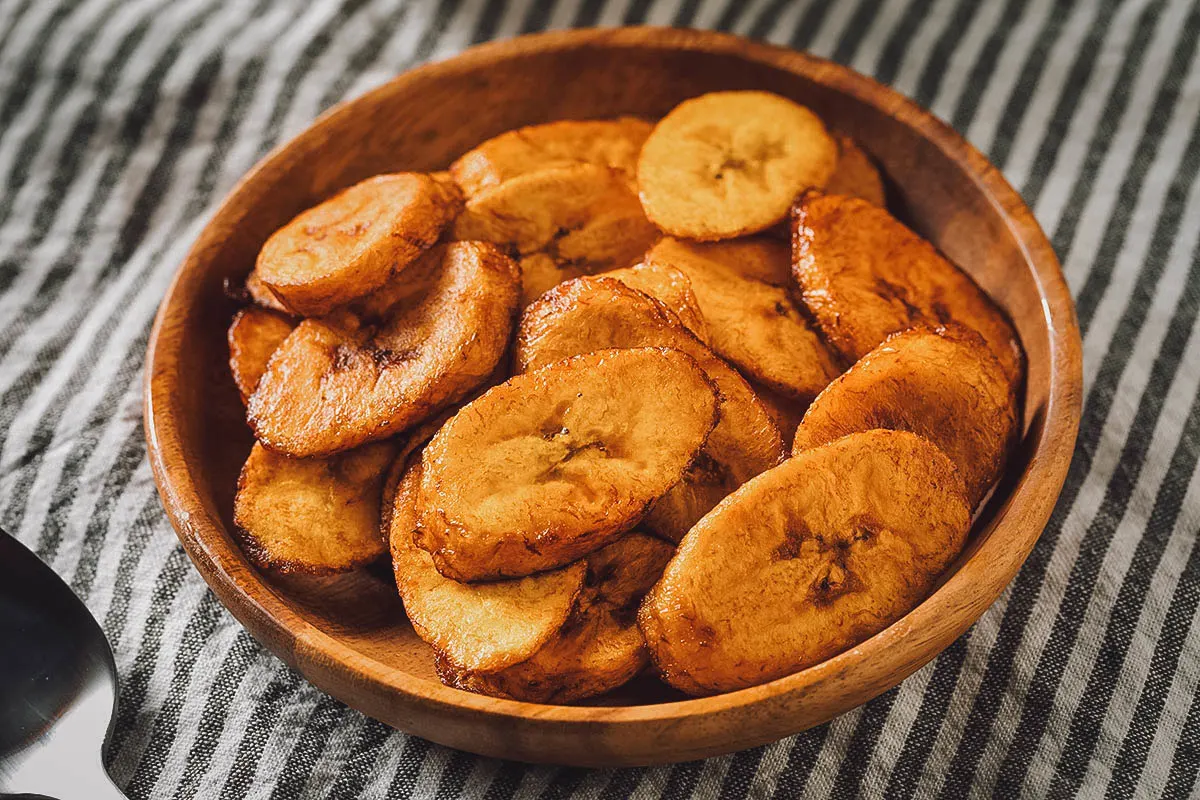
Photo by bhofack2
16. Moin Moin
Moin moin (or moi moi) refers to a type of bean pudding cake. It’s a protein-rich Nigerian dish made with black-eyed peas, onions, and peppers (red bell pepper, scotch bonnet, habanero) that are pureed together and then steamed in a mold with banana leaves.
Depending on the cook, moin moin can be made with additional ingredients like hard-boiled eggs, sardines, bone marrow, and corned beef. Interestingly, each additional ingredient is referred to as a “soul” (or life), so moin moin made with three extra ingredients is known as “moin moin with three souls”.
One of the most popular types of moin moin is moin-moin elemi meje or “moin-moin with seven souls”. The seven extra ingredients are hard-boiled egg, titus fish, lobster, minced meat, green peppers, carrots, and butter.
No matter what it’s made with, moin moin is a versatile dish that can be eaten on its own as a snack, stuffed in bread, or paired with Nigerian foods like jollof rice, white rice, pap (African corn pudding), and dodo.
RECIPE: Moin moin
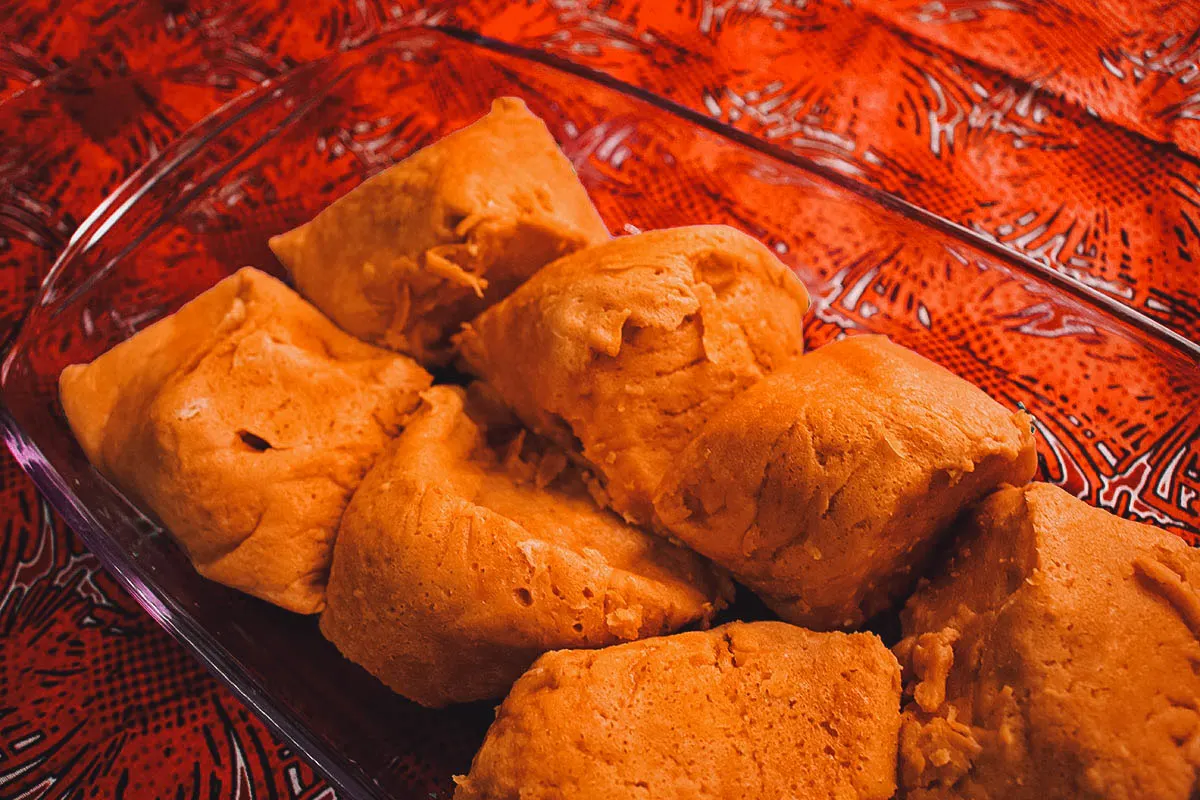
Photo by Afrofresh
MEAT
17. Gizdodo
Gizdodo is a traditional Nigerian dish that gets its name from the two main ingredients used to make it – stewed fried chicken gizzard and dodo. It’s often served at parties and gatherings as an appetizer or as a side dish to Nigerian foods like jollof rice.
Gizdodo is made by boiling and then deep-frying pieces of chicken gizzard. They’re then mixed with fried plantains in a sauce made from tomatoes, bell peppers, hot peppers, and onions.
RECIPE: Gizdodo
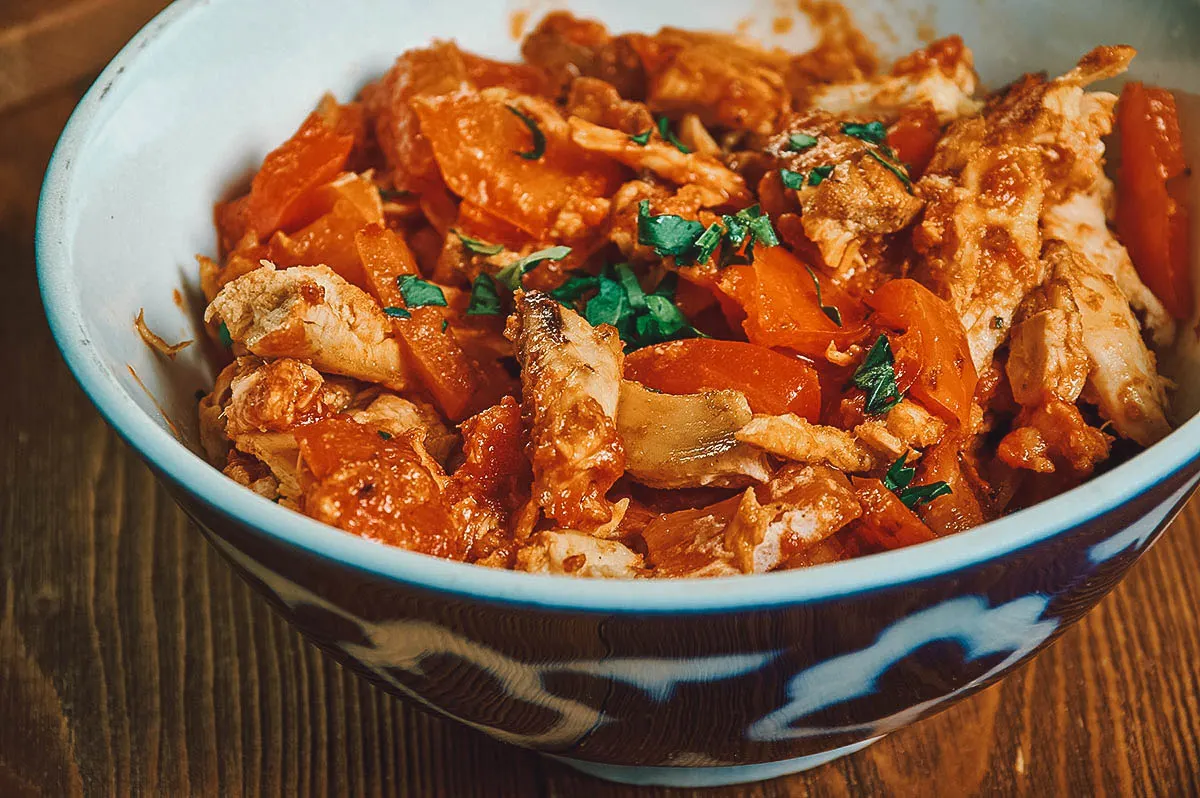
Photo by fanfon
18. Asun
Asun refers to a spicy roasted goat dish native to the Yoruba-speaking Ondo people of western Nigeria. It’s traditionally made with a slow-roasted skin-on goat that’s then chopped up and sauteed in a sauce made from onions, bell peppers, habanero, paprika, and other seasonings.
Goat meat is prized in Nigeria and West Africa and is often the meat of choice at gatherings, special occasions, and holidays like Christmas.
RECIPE: Asun
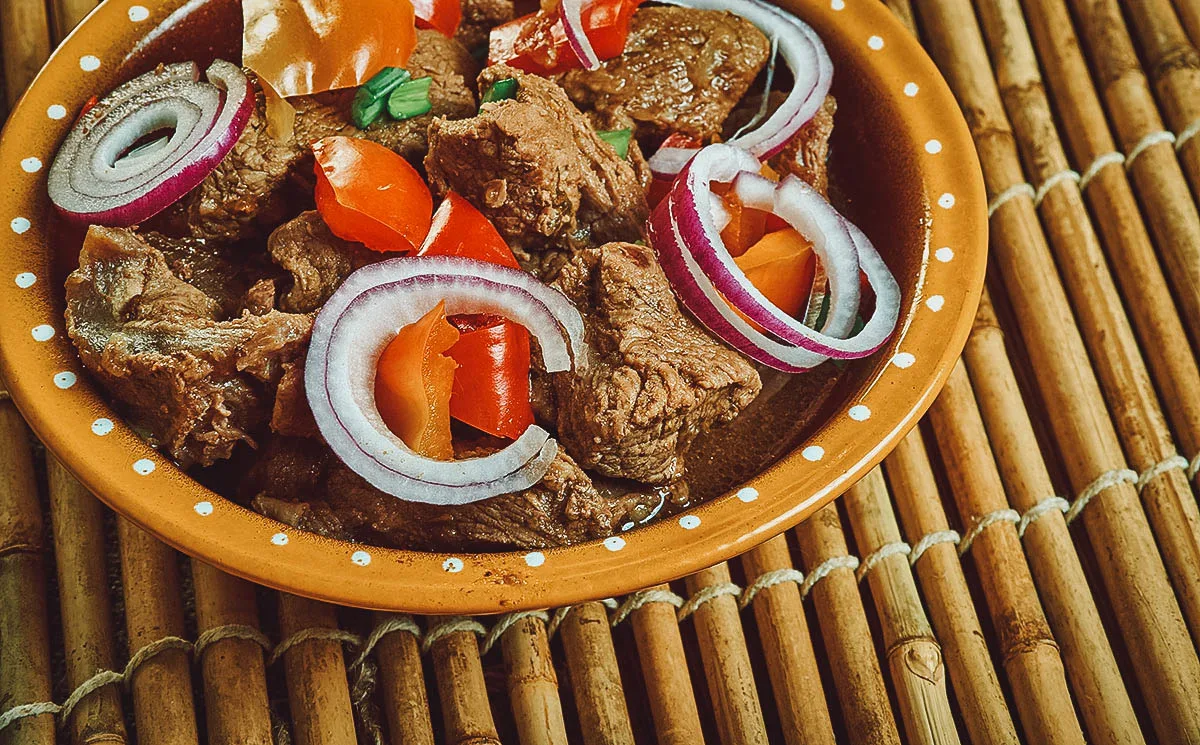
Photo by fanfon
19. Ponmo
Ponmo (or kanda) is an ingredient that’s often used in many Nigerian foods like egusi soup, ofada stew, gbegiri soup, and African salad. It refers to cowhide that’s been processed so it can be used and consumed like beef.
To prepare ponmo, the cowhide is first roasted to soften the skin and help remove the hairs. It’s then soaked in water to soften it further before more delicate skin from areas like the ears and snout are separated from tougher parts like the leg. The remaining hair is then completely removed using a series of specialized tools.
Once the skin is completely free of hair, it’s cut into thin strips and twisted to create curls which are then boiled in hot water. As soon as it thickens and becomes pale, it’s ready to be sold at market.
Aside from being used as a meaty ingredient in many Nigerian dishes, ponmo can also be enjoyed as a snack or as a finger food at parties. One of the most popular ponmo dishes is ponmo alata sue sue, meaning “very hot and peppery cow skin”. It consists of ponmo fried with tomatoes, onions, hot peppers, and seasonings.
RECIPE: Peppered ponmo
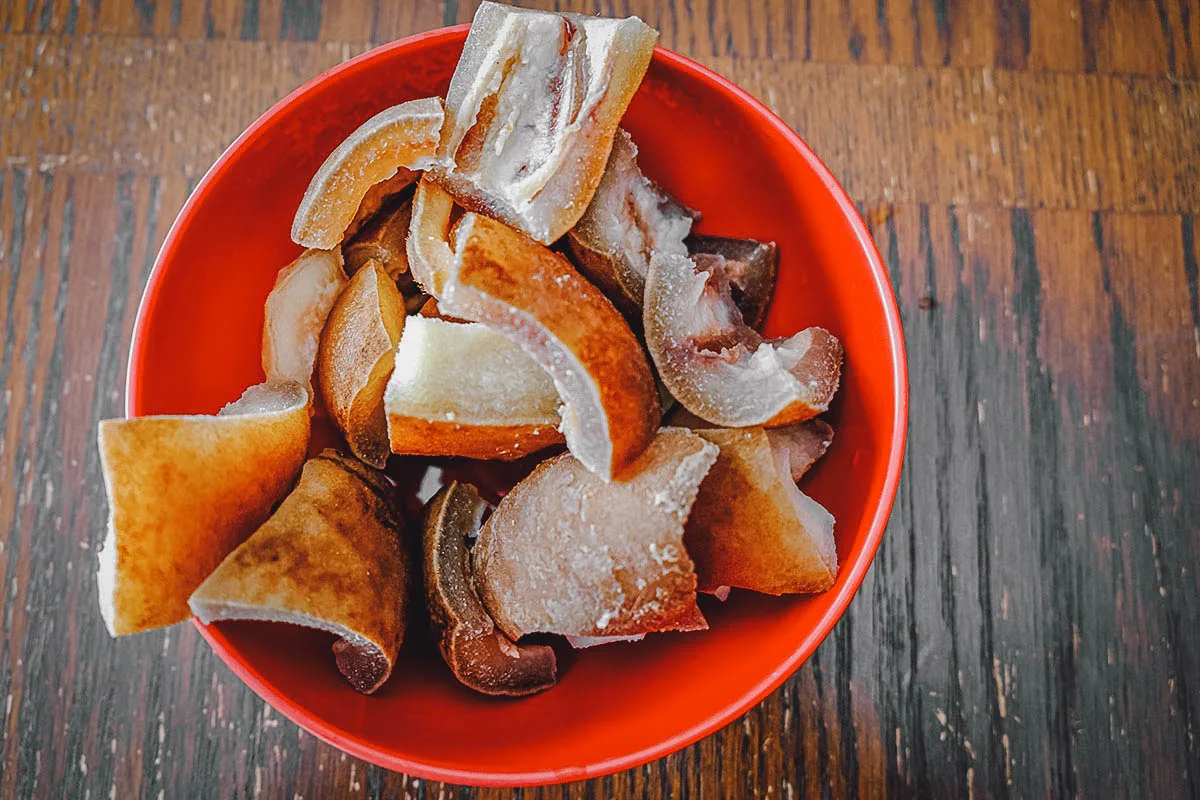
Photo by primestockphotography
STREET FOOD / SNACKS
20. Suya
Suya (or tsire) refers to a skewered spicy meat dish popular in Nigeria and in other parts of West Africa. It’s made with skewered grilled meats like beef, chicken, ram, and offal marinated in a complex mixture of spices called yaji.
Suya is native to the Hausa people of northern Nigeria but it’s now widely consumed throughout the country. It’s commonly sold as street food and eaten at restaurants with a side of fresh cabbage, tomatoes, and onions.
RECIPE: Suya
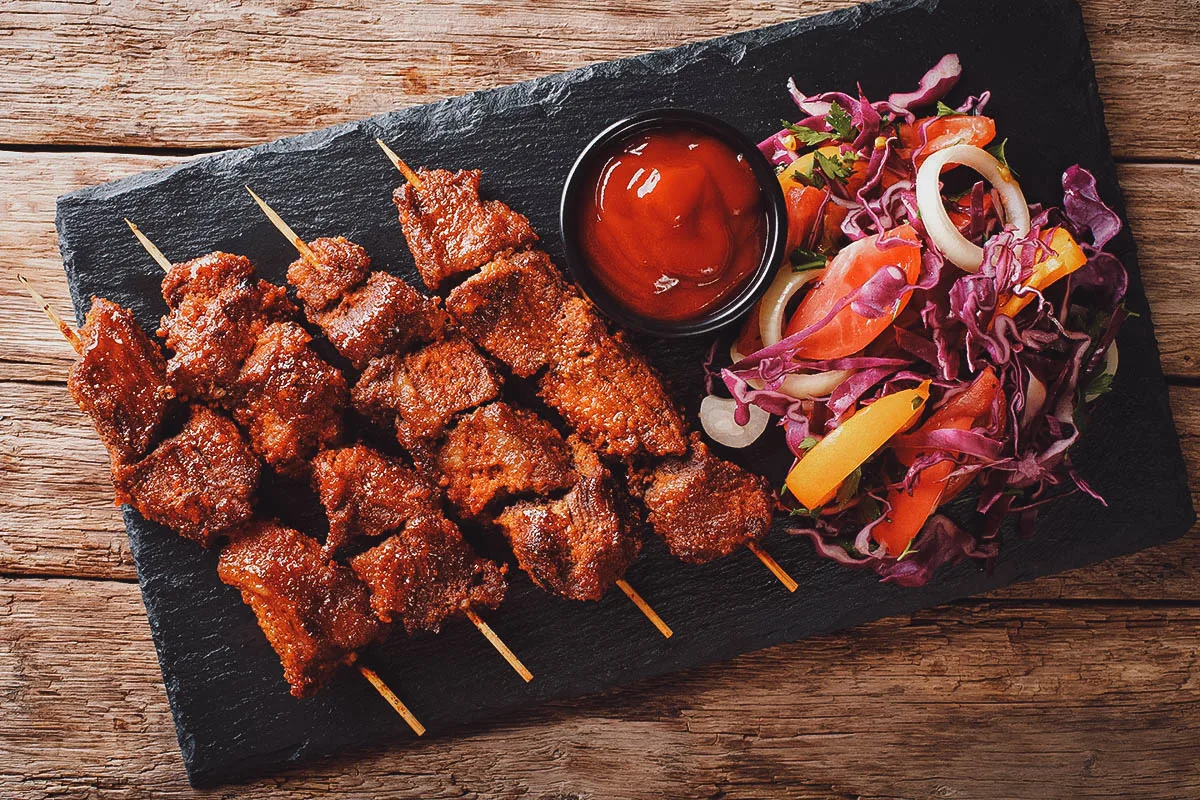
Photo by lenyvavsha
Kilishi is a dried version of suya made with beef, goat, or lamb. It’s basically the Nigerian version of jerky.
To prepare, the meat is sliced into thin sheets and dried in the sun. It’s then coated in a spice paste mixture made with water, labu (peanut paste), onions, salt, spices, and honey. The thin sheets of marinated meat are again left to dry in the sun before being roasted and consumed.
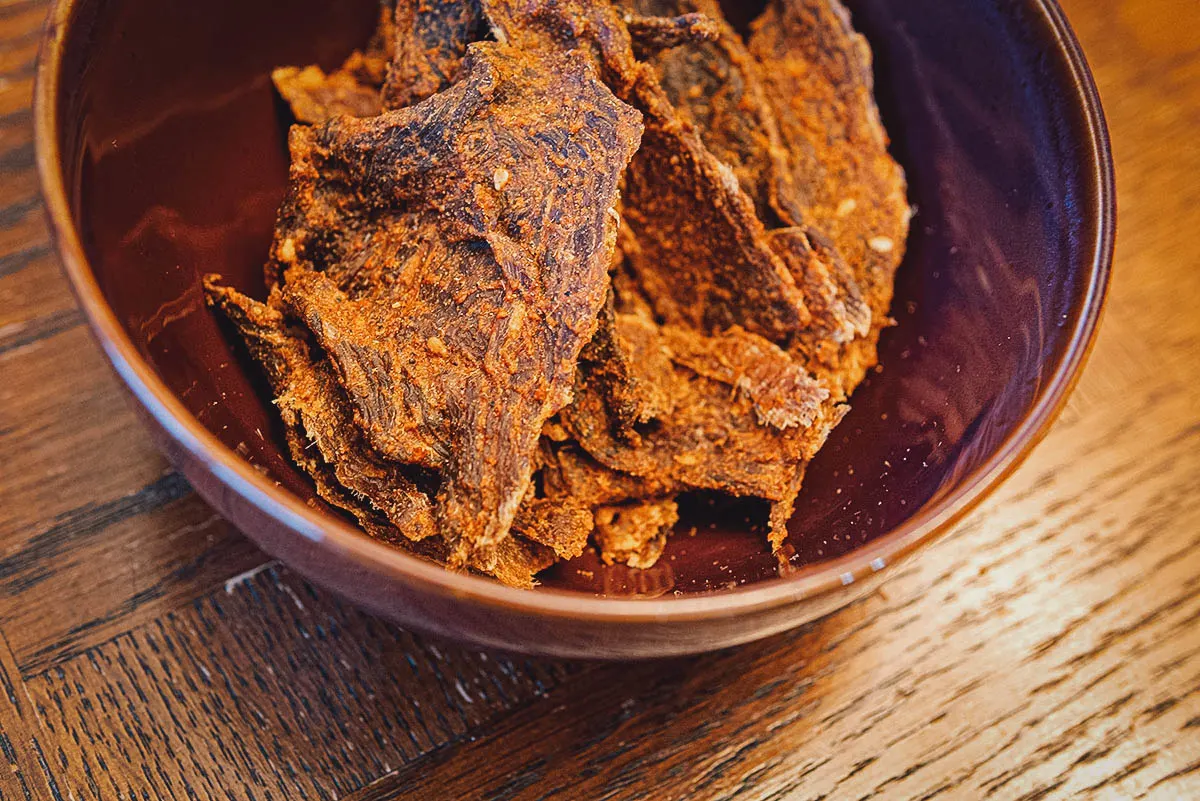
Photo by primestockphotography
21. Boli and Groundnut
Boli (or bole) refers to roasted plantains. It’s a cheap and filling snack that’s commonly sold as street food in Nigeria with roasted groundnuts (peanuts).
RECIPE: Boli and groundnut
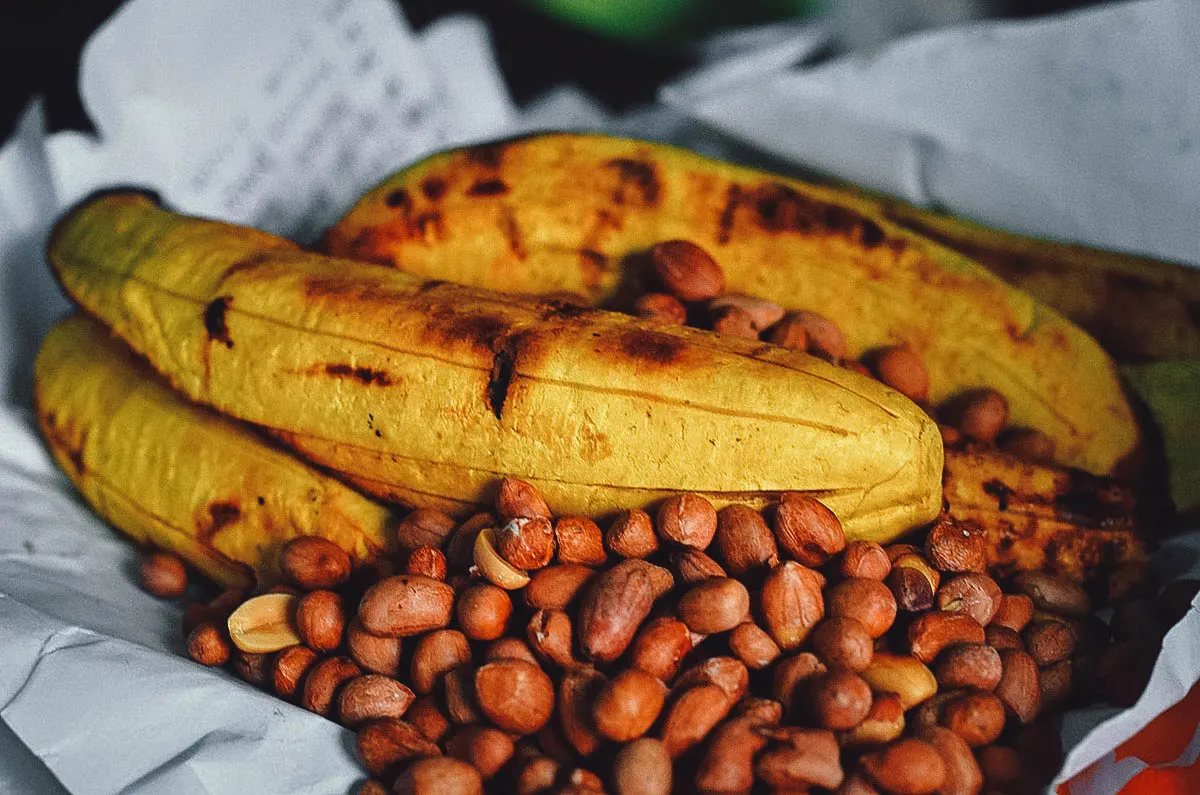
Noahalorwu, CC BY 4.0, via Wikimedia Commons, via Wikimedia Commons / Processed in Photoshop and Lightroom
22. Ewa Agoyin
Ewa agoyin (or ewa aganyin) is a hugely popular street food in Nigeria, especially in Lagos. It consists of extremely soft or mashed beans served with a spicy stew made from bell peppers, hot peppers, onions, and palm oil. Nigerian honey beans (ewa oloyin) are the beans of choice though black-eyed peas can also be used.
Ewa agoyin is commonly sold as street food though it’s often made in many Yoruba households as well. It’s a filling dish that’s usually paired with soft bread, boiled yams, or dodo.
RECIPE: Ewa agoyin
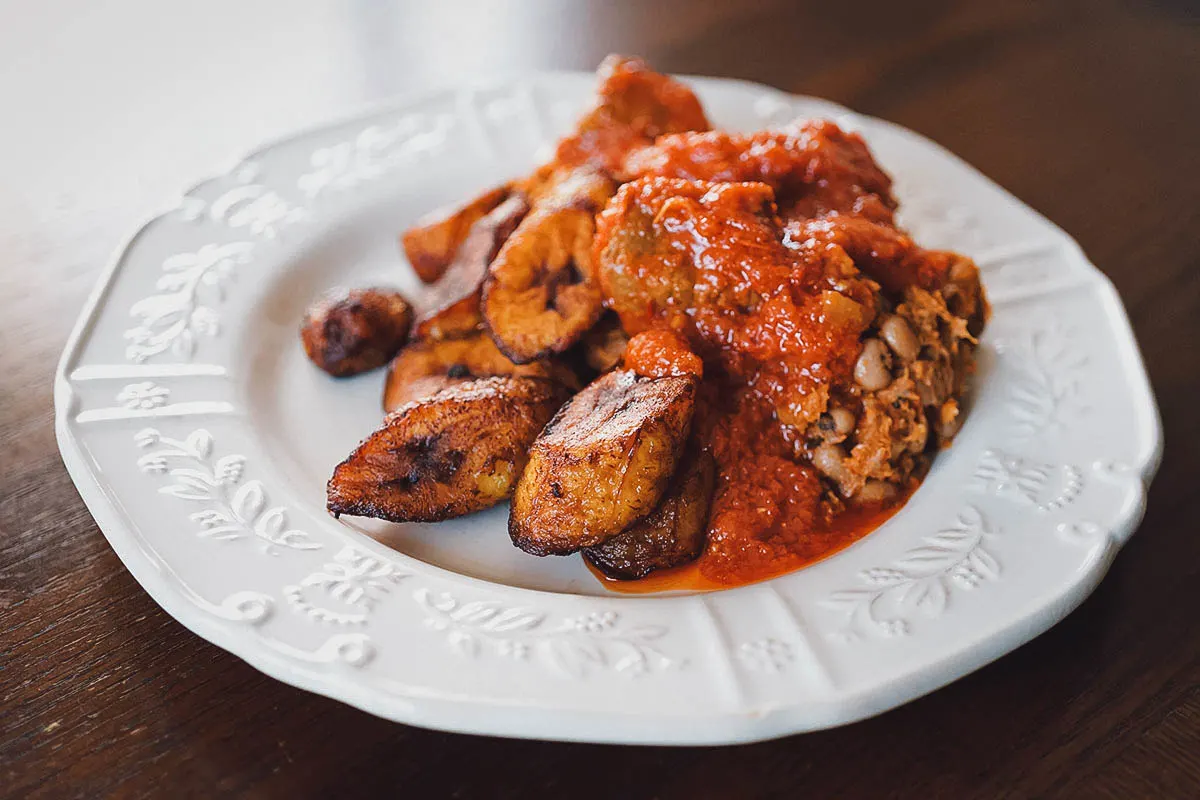
Photo by primestockphotography
23. Akara
Akara (or kosai) refers to black-eyed pea fritters. It’s a common Nigerian street food and breakfast dish that’s popular throughout West Africa and Brazil where it’s known as acarajé. It’s believed that the dish was brought to Brazil by West African slaves.
Akara is made with just four ingredients – black-eyed peas, onions, salt, and pepper. It’s similar to moin moin in that it’s made with pureed black-eyed peas, but instead of being steamed, it’s deep-fried. It can be eaten on its own or served with other Nigerian foods like pap (African corn pudding) or bread.
RECIPE: Akara
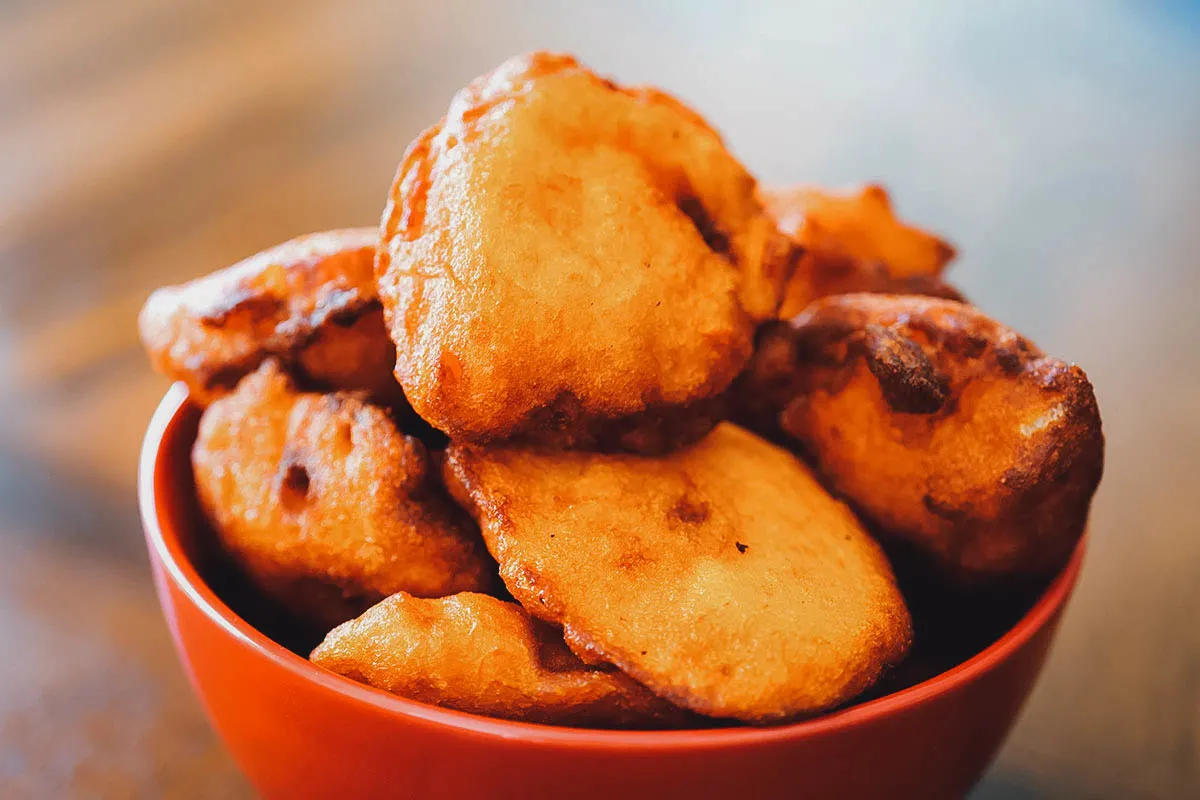
Photo by primestockphotography
24. Chin Chin
Chin chin is a crunchy deep-fried snack made with flour, milk, sugar, margarine, and nutmeg. The ingredients are formed into a dough and then cut into small squares or strips before being deep-fried in vegetable oil. Depending on the recipe, they can range in texture from soft and crisp to very crunchy.
Chin chin is popular in Nigeria and in many parts of West Africa. It was initially prepared for special occasions but it’s since evolved to become a common everyday snack food.
RECIPE: Chin chin
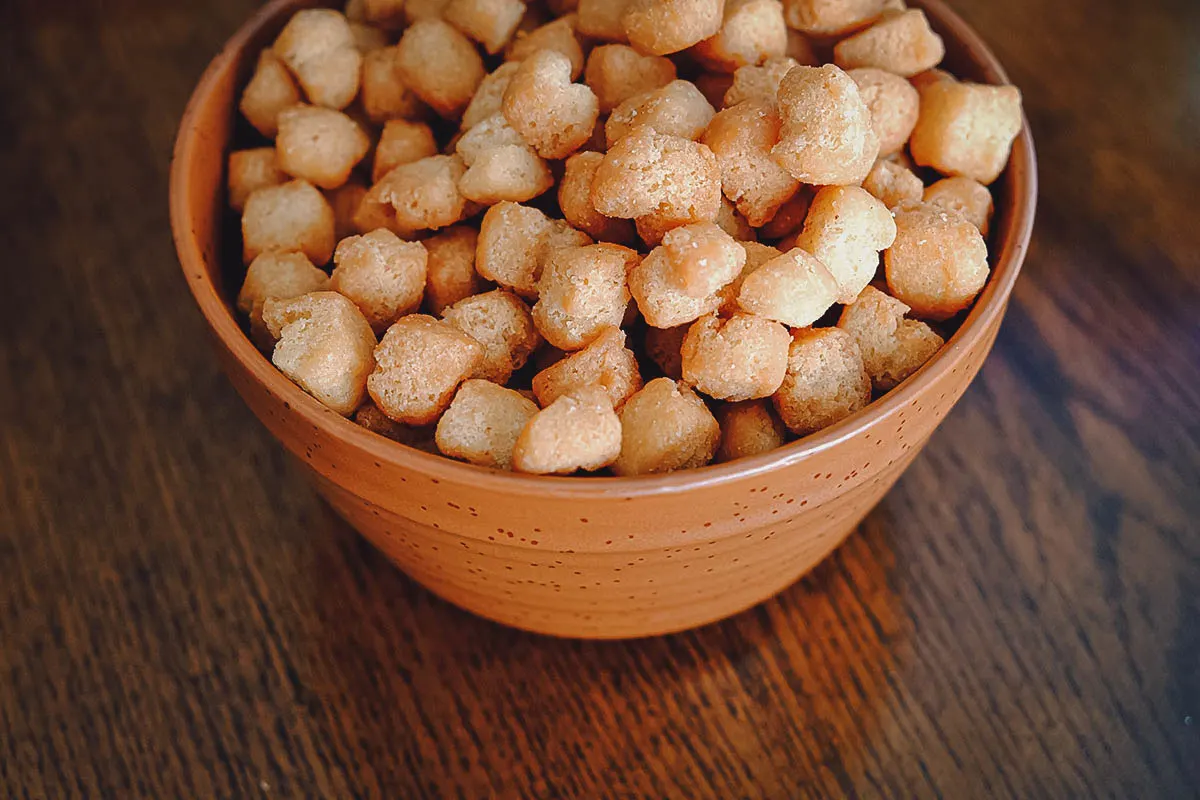
Photo by primestockphotography
25. Puff-Puff
Puff-puff is a hugely popular street food in Nigeria. It’s a ball-shaped doughnut made with flour, yeast, warm water, sugar, and salt. Deep-fried till golden brown, it can be eaten plain or rolled in different sweeteners and flavorings like sugar, cinnamon, vanilla, or nutmeg.
Puff-puff is also popular in many parts of West Africa and beyond where it goes by different names like boflot (Ghana), bofloto (Ivory Coast), kala (Liberia), mikate (Congo), and bolinho (Angola).
RECIPE: Puff-puff
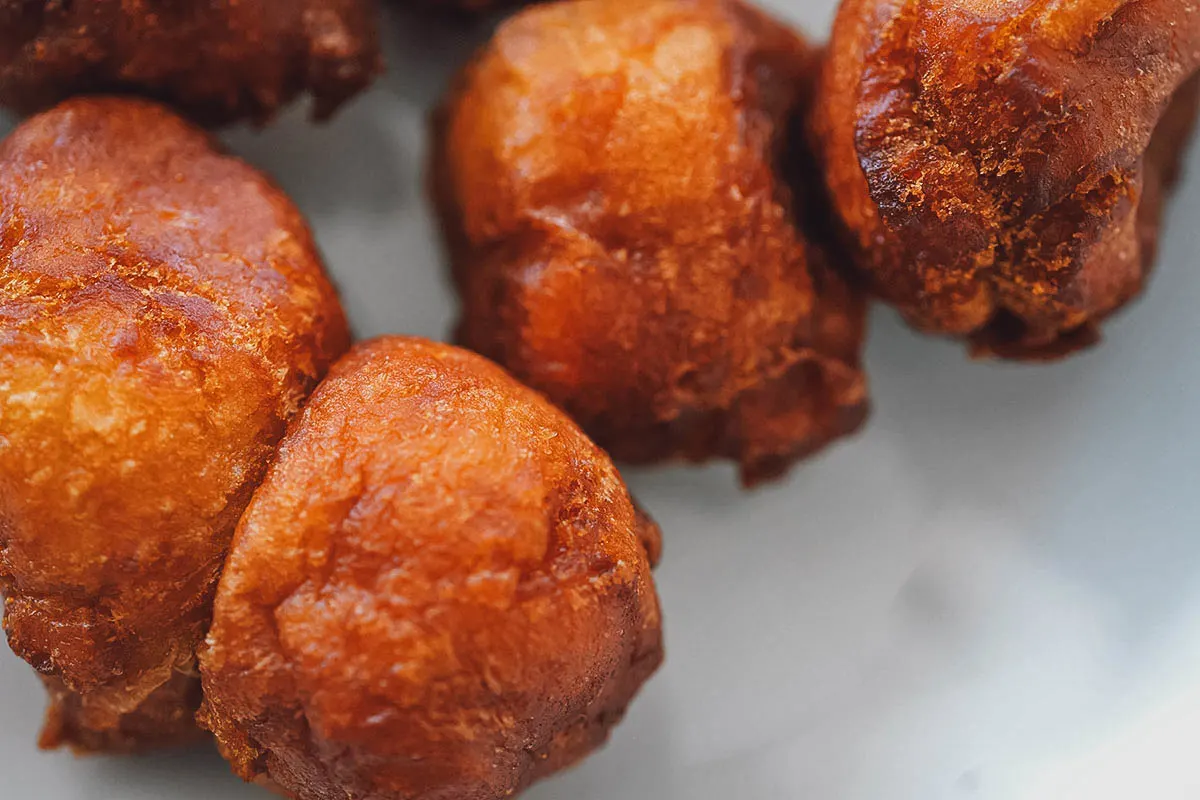
Photo by primestockphotography
FINAL THOUGHTS ON NIGERIAN FOOD
Jollof rice is one of the most famous Nigerian foods and rightfully so, but as this list of 25 shows, there’s so much more to love about Nigerian cuisine. More and more Nigerian restaurants have been opening in major cities around the world so if you haven’t already, then I hope this article gets you even more excited to try Nigerian food.
Cover photo by primestockphotography. Stock images via Depositphotos.


Hiba
Thursday 18th of April 2024
Thank you, much needed, there were many questions regarding the ingredients Nigerian use, it's good to have come across this page.
Edom
Tuesday 26th of September 2023
Your content covered the Nigerian staples extensively, atleast every tribe would find something they all agree with. The pictures for some foods actually appear to be misleading, but kudos for proper coverage. Weldone.
demetrios
Thursday 21st of March 2024
@JB & Renée, this helped me
JB & Renée
Saturday 21st of October 2023
Thanks for the tip and the kind words Edom. We strive to put out the most accurate information so we make corrections whenever we can. Possible to let me know which pictures are misleading?
Boyo
Wednesday 5th of July 2023
Nice content...
Cynthia
Monday 12th of June 2023
Thanks for the write up, will be very helpful for a lot of people. I just wanted to let you know that the pictures you showed for Efo riro and Abacha(African Salad) are totally wrong that's not how they look. Thanks
JB & Renée
Thursday 15th of June 2023
Thanks Cynthia! We'll look into that.